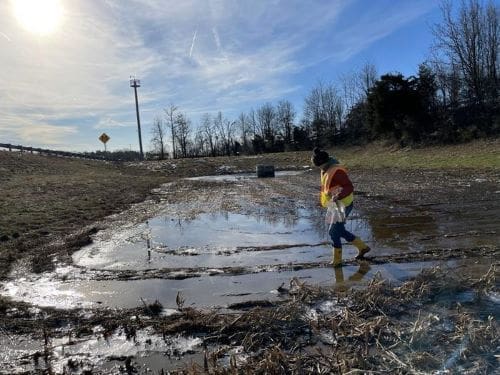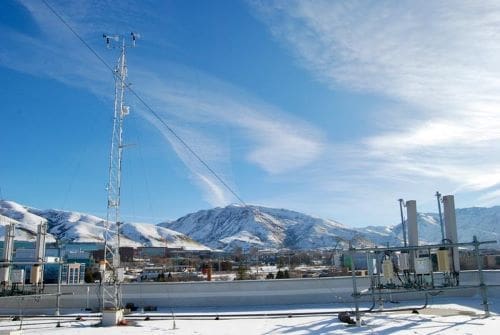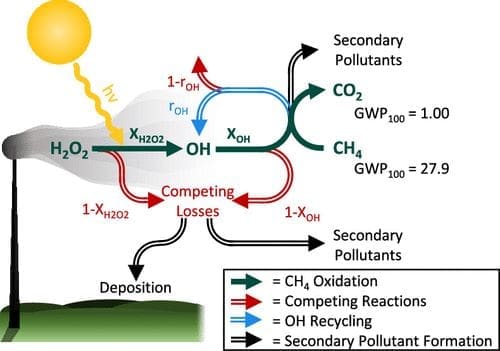Discover the latest articles from leading science journals in the Muser Press weekly roundup, showcasing impactful research published this week.
Table of Contents
Researcher studies the power of native plants to combat road salt pollution
Virginia Tech – Salt pollution in freshwater is a growing global concern.
Excessive salt harms plants, degrades soil, and compromises water quality. In urban areas, road salts used for de-icing during winter often wash into stormwater systems, posing health concerns and challenges for infrastructure.

Specifically, salts can impact the processes like filtration and contaminate retention basins that are used to manage and treat urban stormwater runoff. Megan Rippy, assistant professor in civil and environmental engineering, is on a mission to understand how salt affects plants in stormwater detention basins and assess whether certain plants can mitigate salt pollution through a process called phytoremediation.
“Plants play an important role in green infrastructure performance, but only 1 percent of plants, known as halophytes, can handle highly saline environments,” said Rippy. “This makes it important to characterize the threat salts pose to green infrastructure as well as the potential of salt tolerant species to mitigate that threat.”
Rippy led a yearlong research funded by a National Science Foundation Growing Convergence Research program award. She studied stormwater detention basins in Northern Virginia, exploring the impacts of road salts on plants, soils, and water quality in green infrastructure systems. These basins, designed to manage stormwater runoff and improve water quality, face challenges from road salts used during winter months.
The research published in Science of the Total Environment shows that the amount of salt present in green infrastructure systems does reach levels that threaten plant communities. However, relying on salt-tolerant plants to mitigate the program is unlikely to be effective because they simply don’t assimilate enough salt.
Salt levels and plant resilience
The research found that basins draining roads exhibited the highest salt levels, causing significant stress to plants. Parking lots were next with moderate salt levels, while basins draining grassy areas had little to no salt stress.
Of the 255 plant species identified in the basins, 48 native species showed the ability to tolerate high salt concentrations. Certain plants, particularly cattails, absorbed substantial amounts of salt, significantly higher than other species.
The researchers focused on 14 detention basins across Northern Virginia, measuring salt levels in water, soil, and plant tissues throughout the four seasons. The water samples were analyzed at the Occoquan Watershed Monitoring Laboratory for electrical conductivity and major salt ions. The basins provide drainage for different types of land, including roads, parking lots, and grassy areas.
Can plants solve the salinity problem?
While salt-tolerant plants like cattails showed promise, their impact on overall salt removal was limited. Even in a basin densely planted with cattails, only about 5 to 6 percent of the road salt applied during winter could be removed. This suggests that phytoremediation alone cannot resolve salt pollution but could complement broader salt management strategies that also address winter salt application.
“The amount of salt cattails remove is roughly equivalent to the mass of one to two adults,” said Rippy. “That pales in comparison to the amount we actually apply to the roads and parking lots, suggesting that we shouldn’t expect plants to be a silver bullet solution to our salinization problem.”
Climate change also may alter salt stress dynamics in stormwater systems. As winters in transitional climate zones become milder with more rain and less snow, the amount of salt applied to roads could decrease. This shift might bring salt levels in basins more in line with plants’ ability to absorb and process the salinization.
However, regions with persistent snow cover may experience different challenges, such as delayed deicer wash-off and plant emergence, which could affect salt stress profiles and phytoremediation capacity.
Resilient systems for managing urban salt pollution
This research provides valuable insights into the interplay between plants, salt pollution, and green infrastructure. By understanding how plants tolerate and process salt, Rippy is one step closer to developing sustainable solutions for protecting freshwater ecosystems.
While plants alone cannot solve our salt pollution problem, their role in integrated management strategies is critical. This can offer guidance for urban planners, engineers, and environmental scientists to design more effective stormwater systems to manage runoff, reduce salt pollution, and create greener, more resilient cities.
Journal Reference:
S. Long, M.A. Rippy, L. Krauss, M. Stacey, K. Fausey, ‘The impact of deicer and anti-icer use on plant communities in stormwater detention basins: Characterizing salt stress and phytoremediation potential’, Science of The Total Environment online, 178310 (2025). DOI: 10.1016/j.scitotenv.2024.178310
Article Source:
Press Release/Material by Virginia Tech
Technology for oxidizing atmospheric methane won’t help the climate
University of Utah – As the atmosphere continues to fill with greenhouse gases from human activities, many proposals have surfaced to “geoengineer” climate-saving solutions, that is, alter the atmosphere at a global scale to either reduce the concentrations of carbon or mute its warming effect.
One recent proposal seeks to infuse the atmosphere with hydrogen peroxide, insisting that it would both oxidize methane (CH4), an extremely potent greenhouse gas while improving air quality.
Too good to be true?
University of Utah atmospheric scientists Alfred Mayhew and Jessica Haskins were skeptical, so they set out to test the claims behind this proposal. Their results, published in Environmental Science & Technology confirm their doubts and offer a reality check to agencies considering such proposals as a way to stave off climate change.
“Our work showed that the efficiency of the proposed technology was quite low, meaning widespread adoption of the technology would be required to make any meaningful impact on atmospheric CH4,” said Mayhew, a postdoctoral researcher with the university’s Wilkes Center for Climate Science & Policy. “Then, our results indicate that if this technology is adopted at scale, then we start to see some negative air-quality side effects, particularly for wintertime particulate matter air pollution.”

To conduct the study, the Utah scientists modeled what would happen if you deployed the technology patented by a Canadian company, which is proposing to spray aerosolized hydrogen peroxide, or H2O2, into the atmosphere during daylight hours from 600-meter towers. These towers would approach the height of the world’s tallest radio towers.
“When that hydrogen peroxide is in the presence of sunlight, it’s going to make a really powerful oxidant, the hydroxyl radical OH,” said Haskins, an assistant professor of atmospheric sciences. “That’s a natural scrubber in the atmosphere, and it’s going to help speed up the conversion of methane to CO2.”
Methane is a single-bonded molecule combination of carbon and hydrogen, as opposed to the double-bonded compounds that are far more common in the atmosphere. Hydroxyls are more likely to oxidize those double-bonded molecules, such as the isoprene coming off trees or volatile organic compounds, so OH is just not that efficient for breaking down methane, according to Haskins.
“OH doesn’t react fast with methane,” Haskins said. “It’s reacting with so many other things.”
Methane’s outsized impact on the climate
While carbon dioxide from fossil fuels gets much of the blame for climate change, methane is also a big contributor. Eventually, methane breaks down into carbon dioxide and water.
The primary ingredient in the natural gas burned in home appliances and power plants, methane, or CH4, packs 76 times more climate-warming punch than carbon dioxide over a 20-year timeframe. Methane persists in the atmosphere for only 12 years, but the gas is blamed for nearly a third of the rise in global temperatures since the Industrial Revolution, according to the International Energy Agency.
Anthropogenic sources, primarily oil, gas and coal operations and landfills, account for 60% of global methane emissions.
Artificially speeding up methane oxidation could slow climate change, but such geoengineering projects could carry adverse environmental impacts, which Haskins’s lab seeks to characterize.
A recent report from the National Academy of Sciences concluded the unintended consequences of atmospheric methane removal technologies are likely significant but poorly understood. Haskins’ research is heeding the report’s call to scrutinize these technologies, such as the one that would release vast amounts of hydrogen peroxide.
“We could buy ourselves about 50 years and avoid some of the immediate impacts of climate change if we did this, but no one had actually previously done any side-effects studies to see what was going to happen,” Haskins said. “This is very first paper to assess any air quality side effects of such geoengineering solutions.”
Geoengineering’s potential side effects
Manipulating a system as complex as Earth’s atmosphere is an inherently dangerous action, potentially resulting in unforeseen problems.
“There’s so many feedbacks that can go on in the climate. Atmospheric chemistry is just one example. You change one thing and you think it’s going to do this, but it actually may do the opposite in one place versus the other,” Haskins said. “You have to be really careful and do these sorts of assessments. Is this a responsible thing to do? What’s the impact going to be?”

By way of example, Haskins raised the troubling history of manmade gasses called chlorofluorocarbons, or CFCs, which ate into the protective layer of ozone that shields Earth from harmful ultraviolet radiation.
“We started using CFCs in industry as propellants and refrigerants, and suddenly we cause the ozone hole,” she said. “And we’ve been dealing with the consequences of that for 40 years. And we still won’t have a fully resolved no-ozone-hole year until probably 2060, so we have to be careful of what we’re doing.”
Mayhew and Haskins used a global chemical-transport model, called GEOS-Chem, to simulate the proposal to release hydrogen peroxide from towers. The goal was to estimate how much methane would be oxidized under three different emission scenarios, from light to extreme.
Their simulation envisioned the use of 50 towers spread around North America. Replicating the company’s proposal, the medium-release scenario called for each tower to spray 612 grams, or 1.35 pounds, per second for 10 hours a day for a year.
“This proposed solution just won’t remove any meaningful amount of methane from the atmosphere. It’s not going to solve global warming. At most, we found 50 towers could reduce 0.01% of annual anthropogenic methane emissions,” Haskins said. “You’d need about 352,000 of them to remove 50% of anthropogenic methane. It’s an insane number. And if you did 50 high-emission towers, you’d still need about 43,000.”
In the meantime, places with poor wintertime air quality could see particulate pollution get much worse.
“There’s potential that future research could show that the air quality impacts of placing these towers close to methane point sources is minimal if they’re activated at certain times of the year, and far from large population centers,” Mayhew said. “If that’s the case, then this technology (or similar approaches) could play a very small role in combatting warming, but it’s clear from our work that the air-quality side effects should be placed as a central consideration for any proposed real-world implementation of technology like this.”
Journal Reference:
Alfred W. Mayhew and Jessica D. Haskins, ‘Potential Air Quality Side-Effects of Emitting H2O2 to Enhance Methane Oxidation as a Climate Solution’, Environmental Science & Technology 59, 1, 679–688 (2025). DOI: 10.1021/acs.est.4c11697
Article Source:
Press Release/Material by University of Utah
Other science articles published this week
Super-sized electric vehicles (EVs) will not solve the climate crisis
Gottesfeld P (2025) | PLOS Sustainability and Transformation | DOI: 10.1371/journal.pstr.0000159
Climate dissociations: Trade associations, energy policy and climate communications in Europe
Dinan W, Esteves V, Harkins S, Hills S (2025) | PLOS Climate | DOI: 10.1371/journal.pclm.0000467
What constitutes “institutional arrangements” for Member State reporting within the UNFCCC and Paris Agreement?
Barrins J, McKeown PC, Murray U, Spillane C (2025) | PLOS Climate | DOI: 10.1371/journal.pclm.0000327
Intercomparison of satellite-derived SST with logger data in the Caribbean—Implications for coral reef monitoring
Margaritis G, Kent EC, Foster GL (2025) | PLOS Climate | DOI: 10.1371/journal.pclm.0000480
Networks of climate obstruction: Discourses of denial and delay in US fossil energy, plastic, and agrichemical industries
Kinol A, Si Y, Kinol J, Stephens JC (2025) | PLOS Climate | DOI: 10.1371/journal.pclm.0000370
Measure-and-remeasure as an economically feasible approach to crediting soil organic carbon at scale
Eric Potash et al. (2025) | Environmental Research Letters | DOI: 10.1088/1748-9326/ada16c
Carbon burial in sediments below seaweed farms matches that of Blue Carbon habitats
Duarte, C.M., Delgado-Huertas, A., Marti, E. et al. (2025) | Nature Climate Change | DOI: 10.1038/s41558-024-02238-1
Offshore wind energy: assessing trace element inputs and the risks for co-location of aquaculture
Watson, G.J., Banfield, G., Watson, S.C.L. et al. (2025) | npj Ocean Sustainability | DOI: 10.1038/s44183-024-00101-6
Working-class youth participation in climate action: networks, civic experience, and equity
Naseif, R., Haddad, I. & Almeida, P. (2025) | npj Climate Action | DOI: 10.1038/s44168-024-00205-2
Life-history adaptation under climate warming magnifies the agricultural footprint of a cosmopolitan insect pest
Burc, E., Girard-Tercieux, C., Metz, M. et al. (2025) | Nature Communications | DOI: 10.1038/s41467-025-56177-2
Multiscale wildfire and smoke detection in complex drone forest environments based on YOLOv8
Zhu, W., Niu, S., Yue, J. et al. (2025) | Scientific Reports | DOI: 10.1038/s41598-025-86239-w
Excessive equatorial light rain causes modeling dry bias of Indian summer monsoon rainfall
Li, G., Zhao, C., Gu, J. et al. (2025) | npj Climate and Atmospheric Science | DOI: 10.1038/s41612-025-00916-1
A critical eutrophication–climate change link
Scholz, M.J., Obenour, D.R., Morrison, E.S. et al. (2025) | Nature Sustainability | DOI: 10.1038/s41893-024-01507-3
A time-varying index for agricultural suitability across Europe from 1500–2000
Lehner, A., Philippe, D. (2025) | Scientific Data | DOI: 10.1038/s41597-024-04194-z
The active layer soils of Greenlandic permafrost areas can function as important sinks for volatile organic compounds
Jiao, Y., Kramshøj, M., Davie-Martin, C.L. et al. (2025) | Communications Earth & Environment | DOI: 10.1038/s43247-025-02007-8
Amplification of Northern Hemisphere winter stationary waves in a warming world
Lee, J., Wang, SY.S., Son, SW. et al. (2025) | npj Climate and Atmospheric Science | DOI: 10.1038/s41612-025-00898-0
Featured image credit: kjpargeter | Freepik




